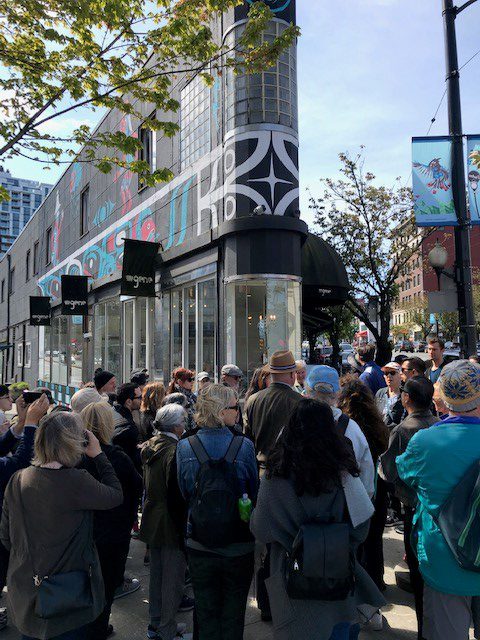 Bridgitte Taylor, Strategic Grantmaking Coordinator at Tides Canada, shares her experience participating in the 2019 Jane’s Walk festival.
Bridgitte Taylor, Strategic Grantmaking Coordinator at Tides Canada, shares her experience participating in the 2019 Jane’s Walk festival.
This past weekend, Jane’s Walk, one of the longest running projects on Tides Canada’s shared platform, kicked off their community walking-tours with walks around the globe. Celebrating the contributions and ideas of renowned urbanist Jane Jacobs, “Jane’s Walk” uses citizen-led walking tours to make space for people to observe, reflect, share, question, and re-imagine the places in which they live.
In Vancouver, a weekend of walks zig-zagged across the city – immersing walkers in topics ranging from urban farming, to public art, to the use of public space. On Sunday, I was delighted to join a group of around 25 other walkers to dive into Vancouver’s historic Mount Pleasant neighbourhood, one of the oldest neighbourhoods in the city. Gathering on the corner of Vancouver’s bustling East Broadway and Main Street, walkers enjoyed a morning in Mount Pleasant’s ‘heritage heart’, observing some of the tangible and intangible histories of the neighbourhood which range from heritage buildings and underground creeks, to legacies of former Mount Pleasant residents and businesses.
Mount Pleasant’s ‘Heritage Heart’

As organizers detailed Mount Pleasant’s legacies, the parallels between the neighbourhood and some of Jane Jacobs’ foremost urban-theories were palpable. Straddling the corner of Main Street and Kingsway at the Gertrude Guerin Plaza, we were greeted with an array of independent storefronts, low-rise buildings, and at least four different transport modes. That being, cars, bikes, busses, and at least a few rollerblades. As we made our way past notable structures and spaces, we were reminded of Mount Pleasant’s embrace of what Jacobs dubbed “mixed-use development” – or the notion that one can live, play, and work all in the same neighbourhood.
The idea that a city should offer something for everyone is one that comes up often in Vancouver, where soaring housing and rent prices are daily topics of conversation. Indeed, while Mount Pleasant’s heritage heart tour celebrated what the neighbourhood has to offer, it also lamented at more recent losses. As blocks of eclectic Main Street prepare for what Jacobs refers to as ‘urban renewal’, and human-scale structures are replaced with higher-density towers, walkers discussed the present-day tensions between liveability and housing-needs. Glancing over our shoulders to the now for sale “Broadway Rooms” however – one of the last affordable housing structures on the block – we were reminded that people, not structures, make cities what they are. Built in the 1930’s, Broadway Rooms continues to exist as a low-rise yet relatively high-density mix of independent storefronts, offices, and homes for artists, activists, newcomers to Canada, and low-income residents alike. Walkers agreed that buildings such as that one are a strong reflection of the community itself. While far from perfect, it was a small reminder that “cities have the capability of providing something for everybody, only because, and only when, they are created by everybody.” – Jane Jacobs (The Death and Life of Great American Cities).
